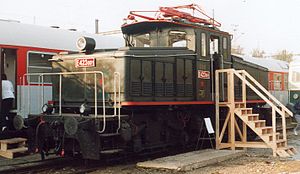ČSD series E 423.0
| ČSD series E 423.0 | |
|---|---|
|
Adamovka
|
|
| Numbering: | E 423.001-002 |
| Number: | 2 |
| Manufacturer: |
Adamov Metropolitan-Vickers |
| Year of construction (s): | 1927-1928 |
| Retirement: | 1973 |
| Axis formula : | Bo 'Bo' |
| Gauge : | 1435 mm ( standard gauge ) |
| Length over buffers: | 11,400 mm |
| Smallest bef. Radius: | 90 m |
| Service mass: | 50 t |
| Friction mass: | 50 t |
| Wheel set mass : | 12.5 t |
| Top speed: | 50 km / h |
| Continuous output : | 540 kW |
| Driving wheel diameter: | 969 mm |
| Power system : | 1.5 kV direct current |
| Power transmission: | electro-pneumatic resistance control |
| Number of traction motors: | 4th |
| Drive: | Paw camp |
The ČSD series E 423.0 was an electric locomotive of the former Czechoslovak State Railways ČSD, which was intended for the 1500 volt direct current electrified network in the Prague node .
history
It was created for shunting and freight traffic on the electrified connecting railways at the Prague hub in 1927 and 1928 by the Adamov company with equipment from the British company Metropolitan-Vickers .
Both locomotives provided service on the connecting lines in Prague for decades . As early as the 1950s, a locomotive was temporarily used on the Hohenfurt Electric Local Railway to cope with the freight traffic triggered by the construction of the Lipno Dam . When the Prague connection line was switched to 3000 V DC on May 15, 1962 , both locomotives were handed over to Vyšší Brod (Hohenfurth), where they handled freight traffic until the new E 426.0 locomotives appeared in 1973. The E 423.002 was then scrapped in December 1974.
The E 423.001 was added to the collection of the National Technical Museum in Prague and was later seen as a non-operational exhibit. In 2003, employees of the PFY in Tábor brought them back to working order. Since then, the locomotive can be seen on museum trips on the Tábor – Bechyně railway line .
technical features
The locomotive has four axles with two bogies, which are mutually connected with a coupling and have pulling and pushing devices on the outside. The main frame is supported on the bogies on sliding plates, which transmit the torque by means of two pivot pins. In the middle of the frame is the driver's cab with two driver's cabs for the engine driver and two stems on the outside. Auxiliary machines and the battery are located in the front porch, while the high-voltage part of the electrical equipment is located in the rear. The machine is equipped with four direct current motors in series with a pivot bearing design. Always two (1st and 3rd, 2nd and 4th) are continuously connected in series. Their voltage is controlled via an electro-pneumatic resistance control with 12 stages in series and 11 stages in series-parallel combination. The last stage switches off the drive motors.
